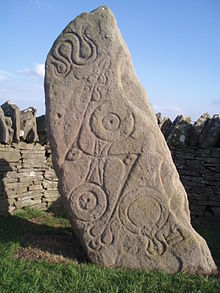This article may require copy editing for grammar, style, cohesion, tone, or spelling. (October 2023) |

Sculptured stones is a name applied to carved stone monuments from the early Christian period excavated in various parts of the British Isles and Scandinavia. They document the conversion of these areas to Christianity.[1][2][3]
They are usually rough-hewn slabs or boulders, some that are standing upright or lying down. Many have runic or lettered inscriptions on them that are Ogham, Scandinavian runes (Old Norse), or Latin.[1][3][4] Some of them are crosses with Celtic knots and other interlacing patterns. Many resemble those found on Celtic scriptures of the Gospels.[5]
Sculptured stones are usually found near ancient ecclesiastical sites, and their date is approximately fixed according to the character of the ornamentation. The stones date from the 26th centuries BCE[6] to 16th centuries CE.[7]
- ^ a b Edwards, Nancy (2001). "Early-Medieval Inscribed Stones and Stone Sculpture in Wales: Context and Function". Medieval Archaeology. 45: 15–39. doi:10.1179/med.2001.45.1.15. S2CID 162335191 – via Art Full Text.
- ^ Sawyer, Birgit (1988). "Scandinavian Conversion Histories". Harvard Ukrainian Studies. 12/13: 46–60. JSTOR 41036304 – via JSTOR.
- ^ a b Cite error: The named reference
:22was invoked but never defined (see the help page). - ^ Holder, Nick; Wardle, Peter (1999). "A disputed early-medieval inscribed stone from Barry, Vale of Glamorgan". Medieval Archaeology. 43.
- ^ Stevick, Robert D. (1999). "Shapes of Early Sculptured Crosses of Ireland". Gesta. 38 (1): 3–21. doi:10.2307/767109. JSTOR 767109. S2CID 192206395 – via JSTOR.
- ^ Jones, Andrew Meirion; Diaz-Guardamino, Marta (2019). "Orkney: Figurines and Sculptured Stones". Making a Mark: Image and Process in Neolithic Britain and Ireland. Oxford, UK: Oxbow Books. pp. 135–141. doi:10.2307/j.ctvjz80kw. ISBN 9781789251883. JSTOR j.ctvjz80kw. S2CID 198642096.
- ^ Brydall, Robert (1905). "Notice of Incised and Sculptured Stones at (1) Luss; (2) Inch Cailleach, Loch Lomond; and (3) at Glendaruel in Argyleshire". Transactions of the Glasgow Archaeological Society. New Series. 5 (1). Edinburgh University Press: 23–31. JSTOR 24681368 – via JSTOR.